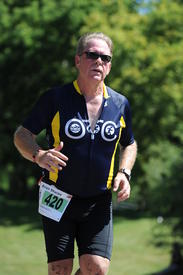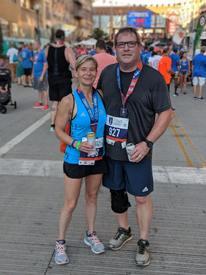Heart rate Zones

SrS5675
Posts: 3 Member
I did my first run (5.25 miles in 49 mins) with a Polar H7 HRM today and see results that I don't quite understand.So,the polar app tells me my max HR is 185 bpm and that 71% of my morning run was in Zone 5 (166+bpm) which is 90% of my heart rate .This can be right since the online guide tells me even elite athletes (which I'll never be) can only stay in that zone for a few minutes at a time..So,what am I doing wrong? Looking for insight from the seasoned pros on this board.Thanks
0
Replies
-
Your MHR is probably higher than you think. How did you determine it (i.e did you use a standard formula or perform a fitness test?)
0 -
Welcome to the world of running! Your confusion stems from the fact that many HRMs still cling to the old 2220-your age as the way of estimating your maximum HR. I'm going to assume that you weren't gasping for air or feeling dizzy during your run?
The most reliable way to do this is a stress test but those cost money and may or may not be available close by depending on where you live. There are some DIY tests (google is your friend here) you can do that will give you a much better idea , many of them will require you to measure your resting heart rate.
Keep in mind also that this is a moving target. As your fitness improves you will probably see a decline in resting HR and what seems difficult now becomes much easier.0 -
Your MHR is probably higher than you think. How did you determine it (i.e did you use a standard formula or perform a fitness test?)
Agree with the bolded. If you used the standard formula (220-age), it is most likely off. According to that, my MHR is under 200, but I have seen 205 on my watch when at a full on sprint (which I can only maintain for a short distance).0 -
Three things:
1. Your max HR is probably higher than 185.
2. Your statement about only staying at 90% of max HR for a few minutes at a time is not true. This is true closer to 98-100% of your max HR. 90% of max HR is usually closer to lactate threshold, which can usually be sustained for up to an hour.
3. You are running too fast.0 -
I think the ideal heart rate zone is the aerobic zone - probably zone 3. Elite athletes dont run in the higher zones because its efficient.
I'm overweight and spend most of my runs in zone 4 on the Mio zone scale. If its too hot or am on slopes then I go into zone 5. Last year I spent most of my run in zone 5, slowed my pace a bit and am now in zone 4 and am aiming for zone 3.
I would think too much time in zone 5 puts undue pressure on the heart.0 -
BrianSharpe wrote: »Welcome to the world of running! Your confusion stems from the fact that many HRMs still cling to the old 2220-your age as the way of estimating your maximum HR. I'm going to assume that you weren't gasping for air or feeling dizzy during your run?
The most reliable way to do this is a stress test but those cost money and may or may not be available close by depending on where you live. There are some DIY tests (google is your friend here) you can do that will give you a much better idea , many of them will require you to measure your resting heart rate.
Keep in mind also that this is a moving target. As your fitness improves you will probably see a decline in resting HR and what seems difficult now becomes much easier.
I was using the Polar default (220-44) ...so I'll do some additional research like you've suggested to get a handle on this..The whole reason I got the HRM was because I thought it would make things easier/more accurate than just using Endomondo..oh well..
0 -
Personally I fail to see why people who run use them. The goal is usually to run whatever distance/terrain one ran previously faster. Obviously this usually means a higher intensity run which raises HR and breathing. And as one gets fitter, they could easily exceed the MHR set by basic standards.
If one is using it approximate calorie burns, there are lots online one could use to do a decent estimate.
A.C.E. Certified Personal and Group Fitness Trainer
IDEA Fitness member
Kickboxing Certified Instructor
Been in fitness for 30 years and have studied kinesiology and nutrition 0
0 -
0
-
You can perform a pretty simple test using Endomondo and your Polar H7 HRM to get a more accurate reading.
When you are well rested go out and run 2 laps of 400m each (so a total of 800m) on flat ground. The first 400m run hard but not all out. In the last 400m run all out. Endomondo will record your highest heart rate which will give you a better idea.
I am presuming from the figures you gave in your OP that you are reasonably capable of running hard and do not have any physical limitations that prevent you from doing so. If in doubt then seek the advice of a decent coach / running club etc.
0 -
One issue with this is if someone runs everyday and twice a day often its physically impossible to run each run progressively faster. So, for these people a HRM can be useful to ensure the training session is in the right intensity to obtain the desired effects.Personally I fail to see why people who run use them. The goal is usually to run whatever distance/terrain one ran previously faster. Obviously this usually means a higher intensity run which raises HR and breathing. And as one gets fitter, they could easily exceed the MHR set by basic standards.
If one is using it approximate calorie burns, there are lots online one could use to do a decent estimate.
A.C.E. Certified Personal and Group Fitness Trainer
IDEA Fitness member
Kickboxing Certified Instructor
Been in fitness for 30 years and have studied kinesiology and nutrition
0 -
You need to slow down for most of your training and all of your long runs. Believe it or not, over time this will build up your cardiopulmonary system, increase your endurance, make you faster, and help to reduce injury.
Try the same distance run at 135HR (warm up first, aim for a range 125-135), see how that feels. You should be able to carry on a conversation without feeling overly winded.0 -
I did my first run (5.25 miles in 49 mins) with a Polar H7 HRM today and see results that I don't quite understand.So,the polar app tells me my max HR is 185 bpm and that 71% of my morning run was in Zone 5 (166+bpm) which is 90% of my heart rate .This can be right since the online guide tells me even elite athletes (which I'll never be) can only stay in that zone for a few minutes at a time..So,what am I doing wrong? Looking for insight from the seasoned pros on this board.Thanks
Did you actually feel like you were red-lining? Chest straps can give crazy wild readings at the start if you haven't wet them (or are not sweating). I have seen 160-200 while I'm barely walking then after 5-10 mins it sorts itself out. I usually slobber all over the contacts then put it on, but sometimes forget. I have a Mio Link optical as well and it's all over the place - I've even watched it climb over 200 while I'm standing still. Then it adjusts and jumps back down.
I figure my zones from races - ideally 10K but you can do the last 20 mins of a 30 mins run as well. Then you extrapolate your max from that avg. Hurts less too.
0 -
lporter229 wrote: »Three things:
1. Your max HR is probably higher than 185.
2. Your statement about only staying at 90% of max HR for a few minutes at a time is not true. This is true closer to 98-100% of your max HR. 90% of max HR is usually closer to lactate threshold, which can usually be sustained for up to an hour.
3. You are running too fast.
I had the same problem OP, found it hard to believe my HR would stay at an average of 183 during a 7 mile run, but apparently this is in the normal range for my age. The above makes sense to me. I link my Polar H7 to Runkeeper and tend to stay between 80-90% for the duration. I do run quite slow though, usually 11 min/mile but this is a comfortable pace for me.0 -
Personally I fail to see why people who run use them. The goal is usually to run whatever distance/terrain one ran previously faster. Obviously this usually means a higher intensity run which raises HR and breathing. And as one gets fitter, they could easily exceed the MHR set by basic standards.
Clearly you aren't a runner, or only have experience running short sprint distances.
For anything else, longer, slower than max pace, runs are a key component of training. The major component in fact for almost every training approach out there.
Longer slower runs should be run well within the individual's aerobic capacity / threshold. If one has a heart rate monitor, try 180-age as an upper heart rate limit (this is *not* your maximum heart rate) and keep HR within 10 beats of that maximum for long slow training runs. Over a period of several weeks the individual will notice their pace improves at that given training maximum heart rate.
Why?
Their aerobic capacity is improving without ever once having engaged in speed work or maximum pace or maximum heart rate endeavours. At the same time they will be able to run farther (more time) and more time (training volume) is key to improving endurance for distance runners.
Yes, speed work has its place too but what the OP needs here is advice as to how to effectively use his new heart rate monitor for the 80 - 90% of his running, not for the minority of it.0
This discussion has been closed.
Categories
- All Categories
- 1.4M Health, Wellness and Goals
- 398.5K Introduce Yourself
- 44.7K Getting Started
- 261K Health and Weight Loss
- 176.4K Food and Nutrition
- 47.7K Recipes
- 233K Fitness and Exercise
- 462 Sleep, Mindfulness and Overall Wellness
- 6.5K Goal: Maintaining Weight
- 8.7K Goal: Gaining Weight and Body Building
- 153.5K Motivation and Support
- 8.4K Challenges
- 1.4K Debate Club
- 96.5K Chit-Chat
- 2.6K Fun and Games
- 4.8K MyFitnessPal Information
- 17 News and Announcements
- 21 MyFitnessPal Academy
- 1.5K Feature Suggestions and Ideas
- 3.2K MyFitnessPal Tech Support Questions









